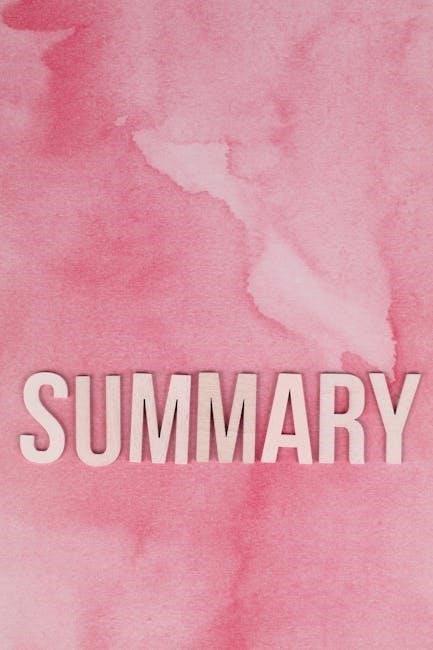1.1 Definition and Purpose
A summary graphic organizer is a visual tool designed to help students condense and organize information from texts or discussions. Its primary purpose is to enhance understanding and retention by breaking down complex content into manageable parts. Often available as printable PDF templates, these organizers guide students in identifying key elements, such as main ideas, characters, settings, and events, fostering effective summarization skills.
1.2 Importance of Summarizing in Education
Summarizing is a cornerstone of education, fostering critical thinking, comprehension, and effective communication. By distilling information into key points, students improve their ability to retain knowledge and express ideas clearly. This skill is essential for academic success, as it enhances both reading and writing abilities, preparing learners to articulate their thoughts concisely in various subjects and real-world scenarios.
Types of Summary Graphic Organizers
2.1 Somebody Wanted But So Then (SWBST) Method
The SWBST method is a popular summary graphic organizer that helps students break down narratives into key elements: Somebody (characters), Wanted (goals), But (conflict), So (actions), and Then (resolution). This structured approach simplifies summarizing by focusing on essential story components, making it easier for students to grasp and communicate the main plot points effectively.
2.2 Story Map: Plot, Setting, Characters, and Events
A story map is a visual tool that helps students organize narrative elements such as plot, setting, characters, and events. By dividing the story into sections, students can systematically record details, enhancing their understanding and ability to summarize. This organizer is particularly effective for fiction texts, guiding learners to identify and connect key components of the storyline cohesively.
2.3 Cause and Effect Graphic Organizer
A cause and effect graphic organizer helps students analyze relationships between events and their outcomes. It typically features sections for identifying causes, effects, and sometimes the underlying reasons. This tool enhances comprehension by visually mapping how actions lead to consequences, making it ideal for both fiction and non-fiction texts. It promotes critical thinking and clear summarization of complex narratives.
2.4 Compare and Contrast Graphic Organizer
A compare and contrast graphic organizer enables students to identify similarities and differences between two or more subjects. It usually includes sections for shared and unique traits, helping learners structure their thoughts visually. This tool is effective for analyzing characters, themes, or concepts, fostering deeper understanding and organized summarization of complex comparisons. It’s versatile for various subjects and age groups.
Benefits of Using Summary Graphic Organizers
3.1 Improving Reading Comprehension
3.2 Enhancing Writing Skills
3.3 Developing Critical Thinking and Organization

How to Use a Summary Graphic Organizer
Guide students to fill in each section after reading, ensuring they identify key points and main ideas. This structured approach helps them form clear, concise summaries effectively.
4.1 Step-by-Step Guide for Students
Read the text carefully and understand its main ideas.
Identify key details that support the main ideas.
Fill in each section of the graphic organizer with relevant information.
Organize the details logically to form a clear summary.
Review and refine your summary to ensure accuracy and completeness.
This structured approach helps students systematically break down and synthesize information effectively.
4.2 Tips for Effective Summarization
To summarize effectively, identify the main idea and supporting details. Use specific methods like SWBST or story maps to organize information. Focus on key events and omit unnecessary details. Practice condensing ideas into clear, concise sentences. Regularly review and refine your summaries to enhance accuracy. These strategies help students develop strong summarization skills and improve their ability to retain and communicate information effectively.

Variations for Different Learning Needs
5.1 Graphic Organizers for Fiction and Non-Fiction
Graphic organizers are tailored for both fiction and non-fiction texts, helping students distinguish between narrative and informational structures. Fiction organizers often focus on plot, characters, and settings, while non-fiction tools emphasize main ideas, details, and concepts. These distinctions enable learners to effectively summarize and organize information based on the text type, enhancing comprehension and critical thinking skills.
5.2 Adaptive Tools for Special Education
Adaptive graphic organizers cater to diverse learning needs, providing structured support for students in special education. These tools often feature simplified layouts, visual prompts, and step-by-step guidance, helping learners with varying abilities to summarize and organize information effectively. By tailoring organizers to individual needs, educators can ensure inclusive learning environments that foster comprehension and confidence for all students.

Digital and Printable PDF Options
Digital and printable PDF options offer flexibility for educators and students, providing accessible tools for summarizing and organizing information effectively in various learning environments.
6.1 Free Printable Templates Online
6.2 Interactive Digital Tools for Engaged Learning
Interactive digital tools offer a dynamic approach to summarization, enhancing student engagement through real-time collaboration and multimedia features. These tools allow learners to organize ideas visually, using features like drag-and-drop options and color-coding. Digital graphic organizers also support differentiated instruction, catering to diverse learning styles and preferences. They foster creativity and active participation, making the summarization process more enjoyable and effective for modern learners.

Integrating Graphic Organizers into the Classroom
Teachers can seamlessly integrate graphic organizers into lesson plans and activities, using them to guide reading discussions, structure writing projects, and promote interactive, engaging learning experiences for all students.
7.1 Lesson Plans and Activities
Educators can incorporate summary graphic organizers into lesson plans by designing activities that align with learning objectives. For example, teachers can use these tools during reading discussions to help students identify key plot points or main ideas. Group activities can involve filling out organizers collaboratively, fostering teamwork and deeper understanding of the material. This approach enhances engagement and reinforces comprehension skills effectively.
7.2 Differentiated Instruction Strategies
Teachers can adapt summary graphic organizers to meet diverse learning needs. For struggling students, simplified templates focus on key elements. Advanced learners can use detailed organizers to explore complex themes. Visual learners benefit from diagrams, while kinesthetic students engage with interactive digital tools. This tailored approach ensures all students can effectively summarize and understand content, promoting inclusivity and personalized learning in the classroom.

Assessing Student Progress with Graphic Organizers
Assessing student progress involves using rubrics to evaluate summaries and providing constructive feedback. This helps students improve their critical thinking and summarization skills effectively.
8.1 Rubrics for Evaluation
Rubrics provide clear criteria for evaluating summaries created with graphic organizers. They assess content accuracy, organization, and conciseness, ensuring fair and consistent assessment. Teachers can create detailed rubrics focusing on specific skills like identifying main ideas or supporting details. These tools help students understand expectations and guide improvement in their summarization abilities over time.
8.2 Feedback and Revision Strategies
Effective feedback and revision strategies enhance learning when using summary graphic organizers. Educators can provide specific comments on clarity, completeness, and accuracy, guiding students to refine their summaries. Peer review and self-assessment also encourage students to reflect on their work. Revision strategies, such as rewriting or reorganizing content, help students improve their ability to convey key ideas concisely and effectively.
Finding and Customizing Summary Graphic Organizers
Teachers can find printable PDF templates online, offering customizable options to suit specific topics or learning needs. These tools are adaptable for various subjects and student levels.
9.1 Recommended Resources and Websites
9.2 Tailoring Organizers for Specific Topics
10.1 Final Thoughts on the Value of Summary Graphic Organizers
10.2 Encouragement for Implementation
Encourage educators and students to embrace summary graphic organizers as a transformative learning tool. Their versatility and accessibility make them ideal for fostering engagement and understanding. With free printable PDF templates and digital options, implementation is seamless. Start integrating these organizers into lesson plans to witness improved comprehension, writing, and critical thinking skills. The benefits are immediate and lasting, making them a valuable addition to any classroom.
